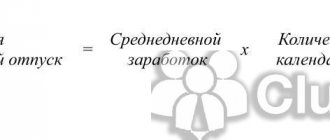Who is entitled to compensation for unused vacation?
When an employee leaves the company, most often he has “non-vacation” days of vacation. The accountant calculates the amount of these conditional vacation pay according to special rules, withholds personal income tax and pays it along with the last salary and severance pay.
No compensation is paid to employees who are simply transferred from one department to another without being fired. It is also not issued to external part-time workers who are transferred to their main place of work. And an employee who was hired less than half a month ago and is now being fired will not receive anything.
What calculations are included in the calculation note
Upon dismissal, an employee is entitled to:
- Compensation for unused vacation - it is paid if the employee has such periods.
- Salary for days actually worked but not previously paid.
- Bonus - if the employee fulfills all the conditions on the basis of which it is assigned.
- Financial assistance - if, in accordance with local regulations or management orders, such a payment is due to an employee.
- Severance pay is paid in cases provided for by law, an employment contract or a formalized termination agreement.
- Other payments that are provided for by law or local regulations of the enterprise.
How to calculate average daily earnings
Average daily earnings for the 12 months before dismissal are needed to find out the amount of compensation for the remaining days of vacation. If an employee joined the organization less than a year ago, calculate the average salary from the moment he was hired (Government Decree No. 922 of December 24, 2007).
We add up the amounts of earnings for the required period: this includes income in cash and in kind - salary and additional payments, bonuses, allowances. The amount does not include sick leave, vacation pay and other payments, for the calculation of which average earnings have already been used.
Next, we determine the number of calendar days for the period and consider working months:
- if the employee worked a full month, we take the average number of calendar days in it - 29.3;
- if there were missed working days in a month (vacation or sick leave), then we find the number of days using the formula: (Number of calendar days of the month - Days of vacation or sick leave) * 29.3 / Number of calendar days of the month .
Now let’s find the average daily earnings using the formula: Amount of payments for the billing period / Calendar days for the billing period .
Convenient calculator
In order not to get confused in long calculations, you can use online services. These are convenient calculators into which the basic values are substituted, and it gives the amount of the required severance pay and other payments.
The disadvantage of such services is that they do not take into account some features : the number of absenteeism, business trips, as well as days of vacation used (if it is non-standard) and days taken due to illness. All this data is stored in the accounting department in a special program. It is impossible to replace the work of a specialist, but you can get an approximate value, which is clarified with an accountant in case of significant discrepancies.
How to calculate compensation for unused vacation
First, understand how many days of the allotted vacation the employee did not take off. We provide a detailed algorithm for calculating this figure here. And in simple cases, when an employee is entitled to 28 vacation days per year, 2.33 vacation days accumulate in a month. If in some months a person worked less than 15 days, we exclude these months from the calculations; if more than 15 days, we round up to a full month. Add the number of months and multiply it by 2.33. From the resulting number, we subtract the days that the employee has already “taken off.”
Calculate the amount of compensation using the formula: Amount of compensation = Average daily earnings * Number of days of unused vacation .
Dismissal Instructions
We have collected links to articles that tell in detail how to properly fire an employee:
- at your own request;
- under a fixed-term employment contract;
- at the initiative of the employer;
- by agreement of the parties;
- by loss of trust;
- for absenteeism;
- on staff reduction;
- for child care;
- due to conscription into the army;
- due to moving to another city;
- for the purpose of transferring to another job.
Indexation of average earnings with salary increases
If before or during an employee’s vacation the organization increased salaries (tariff rates), then it is necessary to index the average earnings to calculate vacation pay. This is where the increase factor (KPI) comes in handy: KPV = OH / OS, where OH is the new salary, OS is the old salary. There are three indexing options:
- The salary increased during the pay period. Then all payments taken into account when calculating vacation pay from the beginning of the billing period to the month of salary change are multiplied by the KVP.
- The salary increased after the pay period before the start of the vacation. The entire calculated average earnings are multiplied by the increase factor.
- Salary increased during vacation. Only part of the vacation pay increases, starting from the effective date of the new salaries.
Reasons for changing working conditions
An enterprise can change its organizational structure. This happens due to the introduction of innovative management and production technologies. In addition, liquidation or reorganization of an enterprise also becomes grounds for changing working conditions.
Innovations are introduced to reduce production costs. The largest of them are the wage fund, raw materials, and energy resources.
Organizational and personnel changes begin with the issuance of a reduction order. The process of liquidation and reorganization is a little more complicated, which requires a decision of the founders, an order, notification of the authority and registration and other mandatory actions. The employee needs to understand that without these procedures, abolition will not be carried out.
In addition, he must be notified 2 or 3 months before dismissal under signature. The redundant employee is entitled to payments specified by law. They protect him from unemployment and allow him to easily find another job within 4-6 months.
Vacation pay
Vacation pay must be paid at least 3 days before the start of the vacation (Article 136 of the Labor Code of the Russian Federation). We take the number of vacation days from the management’s order to provide legal vacation. We pay for all calendar days of vacation except non-working holidays (according to Article 120 of the Labor Code of the Russian Federation).
The situation usually raises questions when vacation starts at the beginning of the month. For example, an employee goes on vacation on July 1, 2018, and vacation pay must be paid on June 27. In this case, the calculation requires the salary for June, which has not yet been accrued.
In this case, the salary calculation for June is first performed: either assuming that the employee will work the last days of the month, or based on the days already worked. Vacation pay is then calculated. If the salary for June changes after calculating vacation pay, you will need to recalculate and pay extra or withhold the difference.
You can calculate your vacation pay in a few minutes using our calculator.
Payment terms
Upon dismissal, the employer is obliged to pay the employee wages for all days worked and financially compensate for unused vacation . At the same time, the Labor Code clearly establishes the payment terms. Article 140 of the Labor Code of the Russian Federation guarantees the employee payment of all amounts due on the day of dismissal.
Expert opinion
Mikhailov Vladislav Ivanovich
Lawyer with 6 years of experience. Specializes in family law. Knows everything about the law.
If in fact this cannot be accomplished, full financial settlement of the employee is allowed no later than the next day after the request for payment is submitted.
If an employee works on a shift schedule and the last shift before dismissal falls on an official day off of the enterprise (Saturday or Sunday), it is possible to organize the return to work of all employees responsible for accounting (for example, an accountant or a personnel department employee).
Paragraph 2 of the above article states that if there are controversial issues regarding the due material payments, the employer, within the prescribed period, pays the former employee an undisputed amount (the maximum amount that both parties to the conflict agree on).
Settlements with a dismissed employee can be made either through bank transactions or in cash.
If on the day of dismissal the employee cannot be present at the workplace (due to illness, time off or vacation), the calculation will be made on the last or next working day.
Along with the due payments, a work book is issued on the last working day.
It is impossible to violate the terms of payments upon dismissal. This requirement is enshrined in Article 236 of the Labor Code of the Russian Federation. For failure to comply with the norm, the employer is financially liable to the dismissed employee.
Namely, the owner of the organization, in case of delay in payment, must pay the employee compensation for the delay in the amount of no less than 1/150 of the Central Bank key rate in effect during the period of delay.
In addition, the interests of working citizens are protected by the norms of the Administrative Code. Article 5.27 provides for administrative liability for violation of labor legislation. An employee who has not received a payment in a timely manner has the right to contact the labor inspectorate and hold the former employer accountable.
Regulatory regulation
Decree of the Government of the Russian Federation dated December 24, 2007 No. 922 “On the specifics of the procedure for calculating average wages”
Letter of the Ministry of Health and Social Development of the Russian Federation dated December 7, 2005 No. 4334-17 “On the procedure for determining the number of calendar days of unused vacation”
Letter of Rostrud dated July 22, 2010 No. 2184-6-1
Regardless of the grounds for termination of the contract, even for guilty actions, the employee upon leaving the company must be paid money for all unclaimed vacation days (see letter of Rostrud dated July 2, 2009 No. 1917-6-1). How to calculate compensation upon dismissal, see the instructions below.
Calculation of severance pay
VP = Add. * Zpos.,
Where:
- VP – severance pay;
- Add. – working days that need to be paid, the number of days of the period is determined according to the enterprise schedule.
According to Art. 14 of the Labor Code of the Russian Federation, the period begins on the day following the date of leaving the organization. Let's look at an example.
Example
Sinelnikov quits due to staff reduction on September 17, 2018, he is entitled to benefits for the period from September 18, 2018 to October 17, 2018. The interval according to the production calendar is 22 working days. We calculate the amount: 22*2630.47 = 57870.34.
If the amount is paid in two weeks, take 14 days following the date of termination of the employment relationship.
Who cannot be fired during a staff reduction?
It is prohibited to dismiss pregnant women, as well as women with children under the age of three, as well as single mothers raising children under the age of 14 (a disabled child under the age of 18). Also on the “prohibited” list are any employees who raise a child under 14 years of age (a disabled child under 18 years of age) without a mother, or are the sole breadwinner of a disabled child under 18 years of age. In addition, it is impossible to lay off an employee who has a child under three years of age if the family has three or more children under 14 years of age and the second parent (legal representative) does not work (Articles 261 and 264 of the Labor Code of the Russian Federation).
ATTENTION. When laying off employees with children, it is necessary to check not only the age of the child, but also the composition of the family.
In addition, there are categories of employees who cannot be fired “due to reduction” within a certain period of time. For example, Part 6 of Article of the Labor Code of the Russian Federation prohibits layoffs of those who are on sick leave or on vacation. It will be possible to dismiss an employee after the end of illness or vacation. Another example is employees who are members of an election commission with advisory voting rights. The reduction will have to wait until the end of the election campaign (Clause 19 of Art. Federal Law No. 67-FZ of June 12, 2002).
It is also impossible to lay off those who received the right to keep their jobs based on the results of an assessment conducted by the employer. Let us remind you that according to the rules of Article 179 of the Labor Code of the Russian Federation, employees with higher labor productivity and qualifications have a preferential right to remain at work. And with equal productivity and qualifications, the following persons can apply for protection from reduction:
- family workers with at least two dependents;
- the only breadwinners in the family;
- employees who received work-related injuries and occupational diseases during work;
- employees aimed at improving their skills without interruption from work;
- disabled people of the Second World War and combat operations to defend the Fatherland;
- Chernobyl workers who received or suffered “radiation” diseases;
- other employees who are granted such a right by the collective agreement.
Before deciding to downsize (especially when it comes to downsizing), the employer must evaluate employees based on these factors. Based on this assessment, a decision should be made as to whether or not they have a preferential right to retain their position.
Compose HR documents using ready-made templates for free











